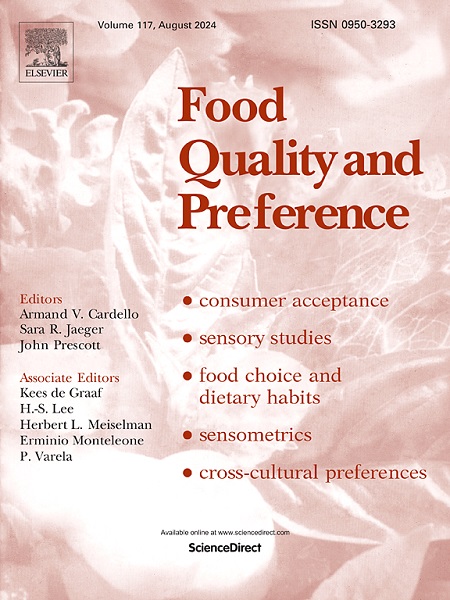Influence of Orthonasal delivery of sweet volatiles on the perception of fruitiness in the mouth
IF 4.9
1区 农林科学
Q1 FOOD SCIENCE & TECHNOLOGY
引用次数: 0
Abstract
This study examined if orthonasal delivery of sweet volatiles associated with strawberry flavor enhanced the flavor perception and liking of a strawberry candy in the mouth. Participants (n = 60) were exposed orthonasally to 3 % v/v of three volatiles common in strawberries: amyl butyrate (AB), ethyl hexanoate (EH) or methyl butyrate (MB), and asked to match them with descriptors. Next, subjects rated key flavor attributes of the candy with simultaneous orthonasal presentation of each volatile at 0, 1.5 and 3 % (v/v). Without an oral stimulus, AB and MB were described as fruity and were associated with sweet taste. With an oral stimulus, AB enhanced sourness, strawberry flavor and mouthwatering (p < 0.03–0.006), while MB decreased sweetness, strawberry flavor, and negatively affected liking (p < 0.03–0.0008). On its own, EH was described as chemical/foul and associated with bitter taste, but when paired with the candy it was found to enhance sourness, fruity flavor, and mouthwatering (p < 0.04). These data suggest that individual fruit-derived volatiles produce unique flavor profiles when paired with in-mouth stimulation.
甜味挥发物的正交鼻传递对口腔果味感知的影响
这项研究考察了与草莓味相关的甜味挥发物是否能增强口腔对草莓糖的味觉和喜爱程度。参与者(n = 60)正交暴露于草莓中常见的三种挥发物:丁酸戊酯(AB),己酸乙酯(EH)或丁酸甲酯(MB)的3% v/v,并要求将它们与描述词相匹配。接下来,受试者对糖果的主要风味属性进行评级,同时将每种挥发物以0、1.5和3% (v/v)的比例正交呈现。在没有口服刺激的情况下,AB和MB被描述为水果味,与甜味有关。通过口服刺激,AB增强了酸味、草莓味和令人垂涎的味道(p <;0.03-0.006),而MB降低了甜度、草莓味,并对喜欢度产生了负面影响(p <;0.03 - -0.0008)。单独使用时,EH被描述为化学物质/恶臭,与苦味有关,但当与糖果搭配使用时,人们发现它可以增强酸味、水果味和令人垂涎的味道。0.04)。这些数据表明,当与入口刺激配对时,单个水果衍生的挥发物会产生独特的风味。
本文章由计算机程序翻译,如有差异,请以英文原文为准。
求助全文
约1分钟内获得全文
求助全文
来源期刊

Food Quality and Preference
工程技术-食品科技
CiteScore
10.40
自引率
15.10%
发文量
263
审稿时长
38 days
期刊介绍:
Food Quality and Preference is a journal devoted to sensory, consumer and behavioural research in food and non-food products. It publishes original research, critical reviews, and short communications in sensory and consumer science, and sensometrics. In addition, the journal publishes special invited issues on important timely topics and from relevant conferences. These are aimed at bridging the gap between research and application, bringing together authors and readers in consumer and market research, sensory science, sensometrics and sensory evaluation, nutrition and food choice, as well as food research, product development and sensory quality assurance. Submissions to Food Quality and Preference are limited to papers that include some form of human measurement; papers that are limited to physical/chemical measures or the routine application of sensory, consumer or econometric analysis will not be considered unless they specifically make a novel scientific contribution in line with the journal''s coverage as outlined below.
 求助内容:
求助内容: 应助结果提醒方式:
应助结果提醒方式:


